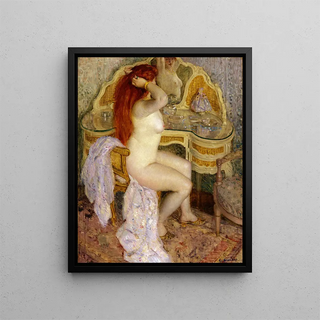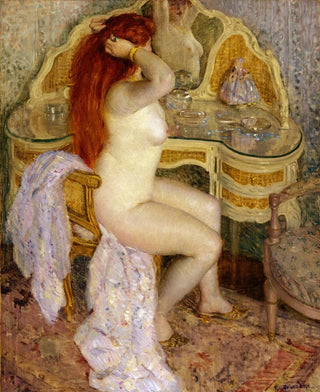Painting Nude sitting at her dressing table - Frederick Carl Frieseke | Art print


View from behind

Frame (optional)
Introducing captivating
The canvas "Nude sitting at her dressing table" by Frederick Carl Frieseke immerses us in a world of delicacy and sensuality. This artwork, emblematic of the American Impressionist movement, captures with remarkable finesse the intimacy of a fleeting moment. The artist, playing with light and shadows, manages to create an atmosphere that is both warm and contemplative. The female figure, at once vulnerable and strong, appears to engage in a daily routine while being enveloped by a halo of beauty. This scene, both simple and complex, invites us to reflect on the beauty of everyday life and how art can elevate seemingly mundane moments.
Style and uniqueness of the work
Frieseke's style is distinguished by his ability to capture light in all its splendor. In "Nude sitting at her dressing table," vibrant colors and fluid brushstrokes bring the scene to life. The color palette, dominated by warm tones, evokes a soft and intimate ambiance. The artist employs layering techniques to render the texture of skin and fabrics, creating a striking contrast between the softness of flesh and the hardness of surrounding objects. The composition is carefully balanced, with each element having its place and significance. Attention to detail, from reflections in the mirror to play of light on the skin, demonstrates undeniable technical mastery. Frieseke succeeds in transforming a moment of solitude into a celebration of femininity and beauty, offering the viewer an immersive and poetic experience.
The artist and his influence
Frederick Carl Frieseke, born in 1874, is one of the most influential artists of his time, representing the American Impressionist movement with a personal touch. Trained in Paris, he draws inspiration from European masters while incorporating elements of his own culture. His work is characterized by a unique sensitivity to light and color, as well as a fascination with everyday life. Frieseke was able to capture intimate moments of life, often centered on female figures, which earned him a prominent place in art history. His

Matte finish

View from behind

Frame (optional)
Introducing captivating
The canvas "Nude sitting at her dressing table" by Frederick Carl Frieseke immerses us in a world of delicacy and sensuality. This artwork, emblematic of the American Impressionist movement, captures with remarkable finesse the intimacy of a fleeting moment. The artist, playing with light and shadows, manages to create an atmosphere that is both warm and contemplative. The female figure, at once vulnerable and strong, appears to engage in a daily routine while being enveloped by a halo of beauty. This scene, both simple and complex, invites us to reflect on the beauty of everyday life and how art can elevate seemingly mundane moments.
Style and uniqueness of the work
Frieseke's style is distinguished by his ability to capture light in all its splendor. In "Nude sitting at her dressing table," vibrant colors and fluid brushstrokes bring the scene to life. The color palette, dominated by warm tones, evokes a soft and intimate ambiance. The artist employs layering techniques to render the texture of skin and fabrics, creating a striking contrast between the softness of flesh and the hardness of surrounding objects. The composition is carefully balanced, with each element having its place and significance. Attention to detail, from reflections in the mirror to play of light on the skin, demonstrates undeniable technical mastery. Frieseke succeeds in transforming a moment of solitude into a celebration of femininity and beauty, offering the viewer an immersive and poetic experience.
The artist and his influence
Frederick Carl Frieseke, born in 1874, is one of the most influential artists of his time, representing the American Impressionist movement with a personal touch. Trained in Paris, he draws inspiration from European masters while incorporating elements of his own culture. His work is characterized by a unique sensitivity to light and color, as well as a fascination with everyday life. Frieseke was able to capture intimate moments of life, often centered on female figures, which earned him a prominent place in art history. His
12,34 €






